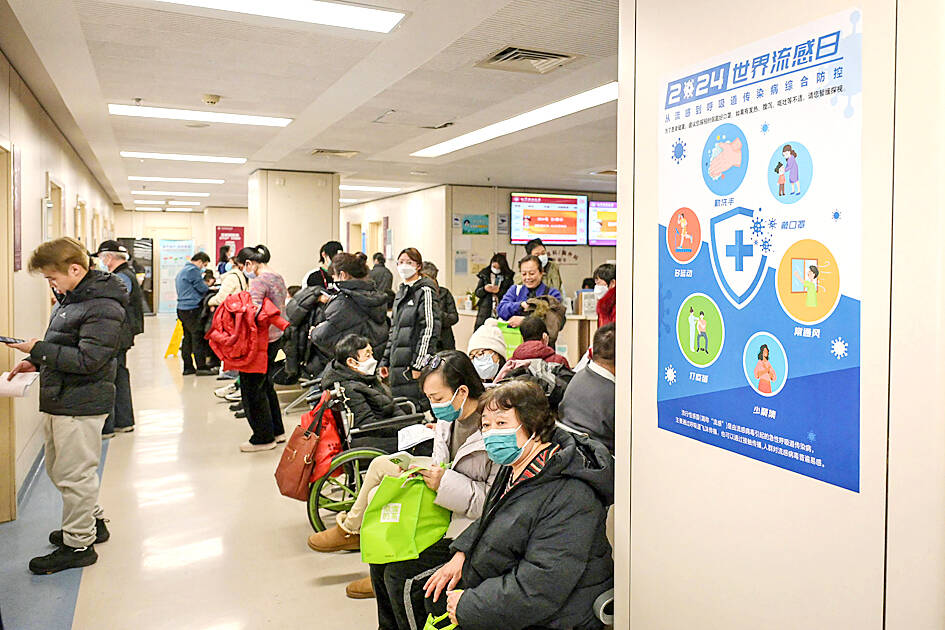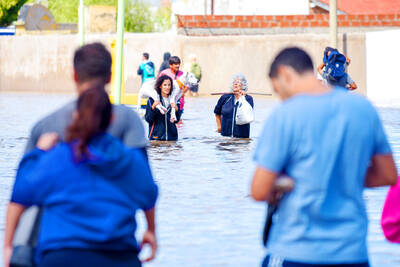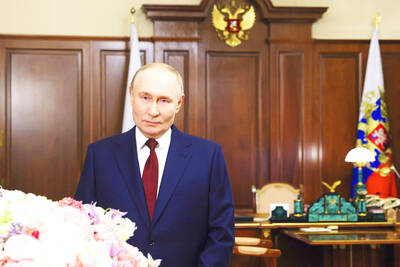A deluge of disinformation about a virus called hMPV is stoking anti-China sentiment across Asia and spurring unfounded concerns of renewed lockdowns, despite experts dismissing comparisons with the COVID-19 pandemic five years ago.
Agence France-Presse’s fact-checkers have debunked a slew of social media posts about the usually non-fatal respiratory disease human metapneumovirus after cases rose in China. Many of these posts claimed that people were dying and that a national emergency had been declared.
Garnering tens of thousands of views, some posts recycled old footage from China’s draconian lockdowns during the COVID-19 pandemic, which originated in the country in late 2019.

Photo: AFP
The falsehoods and fearmongering, which researchers warn could jeopardize the public response to a future pandemic, surged even as the WHO said China’s hMPV outbreak was “within the expected range” for this season.
Philip Mai, co-director of the Social Media Lab at Toronto Metropolitan University, said that the authors of some of these posts were “trying to scare people.”
Mai said there was “an uptick in anti-Chinese rhetoric,” with many on online platforms unfairly trying to blame hMPV cases “on an entire community or culture.”
One video, shared by hundreds of users, showed a confrontation between Chinese citizens and police in medical suits, claiming that the country had begun to isolate the population to tackle hMPV.
AFP fact-checkers found that the sequence portrayed an unrelated altercation that occurred in 2022 in Shanghai.
Other posts claimed that hMPV and COVID-19 had “cross-mutated” into a more severe disease.
However, multiple virologists said the viruses are from different families and impossible to merge.
Adding to the wave of disinformation were sensational, “clickbait” headlines in some mainstream media outlets that described hMPV as a “mystery illness” overpowering the Chinese healthcare system.
In reality, it is a known pathogen that has circulated for decades and generally causes only a mild infection of the upper respiratory tract.
“It’s an example of monetizing panic in an already bewildered public right on the heels of the COVID-19 pandemic,” University of Illinois Chicago epidemiologist Katrine Wallace said. “The truth is that the hMPV is not a mystery illness.”
Such posts have led to a surge in anti-China commentary across Southeast Asia, with one Facebook user going as far as saying that Chinese people “shouldn’t be allowed to enter the Philippines anymore.”
One TikTok video shared an Indian TV news report on the virus but with an overlaid message: “China has done it again.”
“Because of the psychological trauma inflicted by COVID-19 — and by draconian lockdown policies — citizens around the world react anxiously to the possibility of another pandemic emerging from China,” Isaac Stone Fish, chief executive of the business intelligence firm Strategy Risks, said.
“The right response is to distrust what Beijing says about public health, but not assume that means the [Chinese Communist] Party is covering up another pandemic, and certainly not to insult Chinese people,” he added.
Much of the disinformation about hMPV last month came from social media accounts with an Indian focus, before spreading to others with audiences in Africa, Indonesia and Japan, Mai said.
In an apparent bid to ramp up the anti-China sentiment, many of them peddled hMPV falsehoods alongside videos of people eating food that might seem strange or exotic to outsiders. Others used spooky music and old images to sensationalize routine cautions issued by Chinese health authorities.
Many such posts on X reached millions of viewers without a Community Note, a crowd-sourced tool to debunk false information.
“My concern is that all of the fearmongering about hMPV now will make it harder for public health officials to raise the alarm about future pandemics,” Mai said.

ANGER: A video shared online showed residents in a neighborhood confronting the national security minister, attempting to drag her toward floodwaters Argentina’s port city of Bahia Blanca has been “destroyed” after being pummeled by a year’s worth of rain in a matter of hours, killing 13 and driving hundreds from their homes, authorities said on Saturday. Two young girls — reportedly aged four and one — were missing after possibly being swept away by floodwaters in the wake of Friday’s storm. The deluge left hospital rooms underwater, turned neighborhoods into islands and cut electricity to swaths of the city. Argentine Minister of National Security Patricia Bullrich said Bahia Blanca was “destroyed.” The death toll rose to 13 on Saturday, up from 10 on Friday, authorities

DEBT BREAK: Friedrich Merz has vowed to do ‘whatever it takes’ to free up more money for defense and infrastructure at a time of growing geopolitical uncertainty Germany’s likely next leader Friedrich Merz was set yesterday to defend his unprecedented plans to massively ramp up defense and infrastructure spending in the Bundestag as lawmakers begin debating the proposals. Merz unveiled the plans last week, vowing his center-right Christian Democratic Union (CDU)/Christian Social Union (CSU) bloc and the center-left Social Democratic Party (SPD) — in talks to form a coalition after last month’s elections — would quickly push them through before the end of the current legislature. Fraying Europe-US ties under US President Donald Trump have fueled calls for Germany, long dependent on the US security umbrella, to quickly

Local officials from Russia’s ruling party have caused controversy by presenting mothers of soldiers killed in Ukraine with gifts of meat grinders, an appliance widely used to describe Russia’s brutal tactics on the front line. The United Russia party in the northern Murmansk region posted photographs on social media showing officials smiling as they visited bereaved mothers with gifts of flowers and boxed meat grinders for International Women’s Day on Saturday, which is widely celebrated in Russia. The post included a message thanking the “dear moms” for their “strength of spirit and the love you put into bringing up your sons.” It

In front of a secluded temple in southwestern China, Duan Ruru skillfully executes a series of chops and strikes, practicing kung fu techniques she has spent a decade mastering. Chinese martial arts have long been considered a male-dominated sphere, but a cohort of Generation Z women like Duan is challenging that assumption and generating publicity for their particular school of kung fu. “Since I was little, I’ve had a love for martial arts... I thought that girls learning martial arts was super swaggy,” Duan, 23, said. The ancient Emei school where she trains in the mountains of China’s Sichuan Province